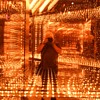Posted 15 years ago
 rniederman
rniederman
(350 items)
One of my goals as a collector is to understand cameras, their purpose, and the builder’s intent. The camera shown here was patented in 1883 by G. Frank E. Pearsall; a well known Brooklyn photographer who opened his first studio in the 1870s. As a famous portraitist, Frank made images of celebrities, politicians, and the wealthy. One of his best known pictures is a portrait of Walt Whitman.
There are only three known examples of Pearsall's Compact Camera; which would lead us to believe it was a commercial failure - but it was actually a radical departure in camera design and unlike anything seen before it. This was the first camera that could completely fold into its own protective case (all delicate parts were completely encased within the outer body).
Unbeknownst to Pearsall at the time, the ‘DNA’ of his Compact Camera would eventually be rediscovered in 1890 by George Eastman, adopted by all major builders, and appear in every one of the smaller, refined self-casing cameras made through the mid 1900s!
But what about Frank: What was the motivation for a successful Brooklyn based gallery owner and portraitist to suddenly build his own camera? After years of research, I am getting closer to the answer.
Along the way, I was fortunate to acquire a late 1860s tintype portrait of Frank Pearsall – apparently in his 20s – and a business card with an early studio address. Even if I don’t unravel the mystery of why Frank built this fascinating camera, it’s satisfying to know that I’ve reunited the maker and his camera.
BTW … don’t let the Pearsall family portrait fool you. The business card and tintype are small in comparison to Pearsall’s “Compact” camera.






















The motivation was simply the fact that he knew he could make a better product. Creativity shows up in many forms, it could be posing clients for portraits or composing a shot or designing a new camera. The trigger could have been the result of a camera damaged because it's working parts were exposed.
I love craftsmanship in any form.
Thanks, walksoftly! Your thoughts are closer to reality than you know. I've researched this for many years. It appears that the portable camera design was created because Pearsall needed something to take to the ballpark ... that's right ... 1880s baseball. It ends up that Frank was Henry Chadwick's personal photographer. And as most folks are aware, Chadwick is often called 'the father of baseball'. There's a Chadwick comment I'm researching with the Baseball Hall of Fame Library in which he supposedly said something along the lines of; "Pearsall invented a portable camera appropriate for baseball." This is a great example of creativity and building a better product as you noted. Somewhere in all the baseball literature and interviews I'll find the primary source.
Well I don't know much about baseball, but I do know a thing or two about designing & inventing, & it doesn't take much to get the creative juices flowing.
Good luck in your quest for info.
Thanks Bellin and JohnK!
Thanks eye4beauty and officialfuel!
Thanks, Scott!
Thanks, mustangtony!
Thanks mtg75 and AntigueToys!
I have a question.
Do you know the measurements of this camera?
If so can you tell me?
The height, width, and length.
Thanks
The camera is 13" tall x 12-1/2" wide x 6-3/4" deep (closed) or 19" deep when opened as shown.
Thanks, Don!
Thanks, aghcollect!
Thanks, JosephIssac!
Nearly all cameras today produce rectangular photos because the sensors (film or digital) are rectangular. A typical camera lens could produce a larger round image if the sensor were larger... I didn't know this Rob,.. didn't realize that the first pictures were all round and part of the reason was so people could take pictures as well as professional and could shoot and not be concern about them being level,......
Thanks for the comment, Roy ... yup ... that's the idea but let me further refine the thinking and put into context. Lenses are designed to throw circular images that are slightly bigger than their respective rectangular (or square) format cameras. A bigger sensor (or plate or film) could be made to extend to a lens' image-circle edges but it isn't useful for a couple of reasons. First, rectangular (or square) formats are easier to look at and work with than circular images. Second, the image quality at the extreme edges of the image-circle gets poor. Third, you would end up with a lot of odd (non-standard) formats. As such, lenses are optimized to the format, film or sensor with a bit of extra image all the way around. Think of the sensor (film and plate) positioned in the optimal 'sweet-spot' of the image-circle. The exception is with view cameras that have movements such as swings, tilts and shifts that exploit a larger field of image. Lenses designed for large formats throw really big image-circles in relation to the format. I cover this in another post: https://www.collectorsweekly.com/stories/187831-scovill-waterbury-view-camera-c-1888 (refer to comment #2).
In regards to round pictures, they were briefly popular with Kodak's early box cameras. Yet the very first commercial cameras (starting in 1839) had rectangular image formats.
Thanks, oldpeep!